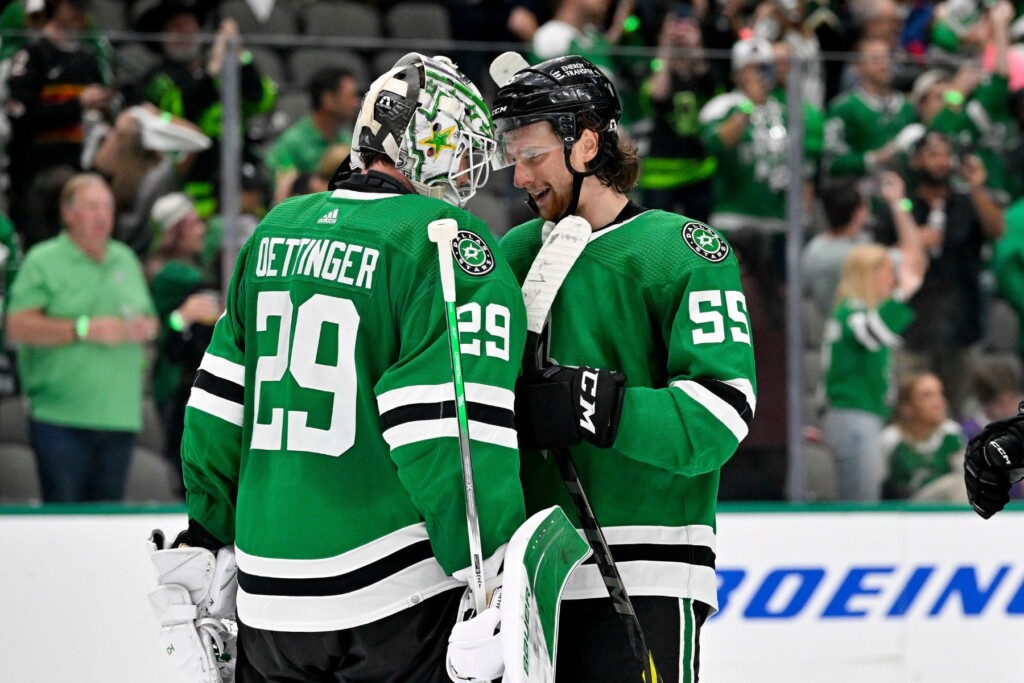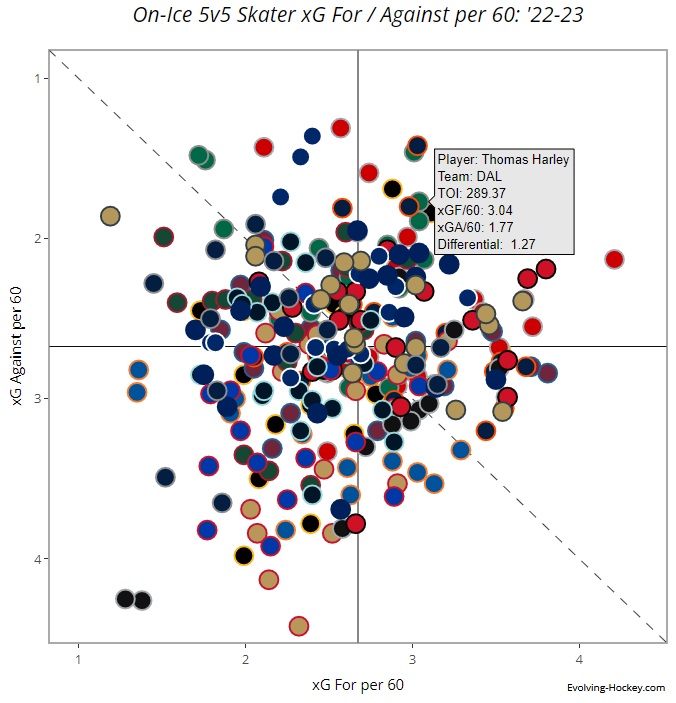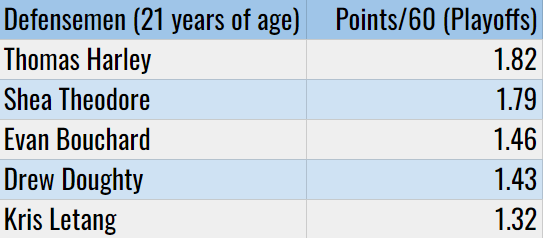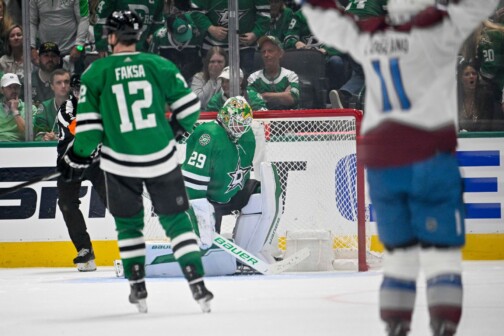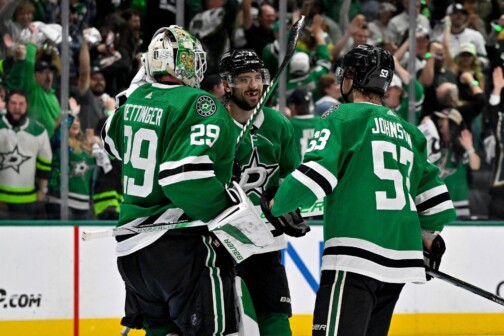If you’re like me, you probably forgot Thomas Harley played a whopping 34 games as a rookie in 2021-2022. But that disconcerting debut never made me worry he’d be a bust. Why? Because I never forgot Scott Wheeler’s analysis of him in 2020 during the Rick Bowness era: “I hope his style of play doesn’t get coached out of him, because he’s at his best when he’s using his dynamic qualities to push, rather than sitting back and making short passes.”
Whether coaching or Bowness’ suffocating system were responsible for his somewhat listless performance that year is beside the point. The newly acquired Nils Lundkvist forced him back to Cedar Park to begin the 2022-2023 season, a byproduct of Lundkvist being the shiny new puck-moving toy (and a right-handed shot to boot) while Harley’s defensive game needed legitimate work. Even now he’s still prone to shortcutting defensive routes with the odd lazy pokecheck, moving his legs when he should be moving his brain, or moving his hands when he should be moving his legs.
But once Harley found his way back into a victory green uniform in April, he looked reborn. In fact, his first shift was so good there’s even a highlight of it. This isn’t a huge surprise considering Pete DeBoer’s system is all about shortening the neutral zone with quick exits and defensemen carrying pucks deep into the offensive zone, both of which are hallmarks of Harley’s game. Still, it was jarring in the best way possible to see Harley go from the minor leagues to Dallas’ second-best defenseman in two months’ time by the time Dallas’ playoff run had ended.
A lot of credit goes to Texas Stars coach Neil Graham. The gameplan in Cedar Park was not just about Hartley focusing on defense, but specifically his defensive transitions, emphasizing the zone exits that DeBoer stresses as essential to blueline play. And as good as Harley looked in his first regular-season shift, it was nothing compared to the stabilizing presence he became in the 2023 postseason—no small feat for a 21-year-old, high-octane puck mover. He led the team in expected goal share (59.47 percent), shot attempt differential (59.97 percent), and goal share (an absurd 77.73 percent.) The Stars were a -41 in shot attempts without Harley on the ice, by far the best mark of any blueliner in those 19 critical games.
The Seattle series was a particular high point. While the Vegas series is probably fresher in fans’ minds, the Kraken were the team that exposed the blueline from top to bottom. The inimitable Miro Heiskanen only had one even-strength point in that series, the same amount as Ryan Suter. Esa Lindell would rather forget about the whole thing. Meanwhile, Harley had seven points, all at even strength. The youngest player in the group carried his positionmates on his shoulders.
The last thing worth pointing out is that his expected goal share wasn’t just the best on the team. It was among tops among all postseason performers.
Last month I wrote an in-depth look at Wyatt Johnston, trying to weaponize fancy data into a hard prediction about his career trajectory. Making a 60-point projection for Johnston was easy because he produced in a way that only a handful of forwards his age ever had. The sample was large enough that we could follow up with an educated guess of what Johnston could deliver the following season.
Harley, conversely, only played a handful of regular-season games. So, again, we turn to the postseason. Nineteen games is a pretty decent sample, and nine even-strength points is a lot. And a 21-year old defenseman leading his blueline in even-strength points, third overall behind Roope Hintz and Max Domi and ahead of 100-point scorer Jason Robertson? That’s rare.
Here’s the company Harley keeps:
I count 10 All-Star selections, one Norris Trophy, two Olympic gold medals, and six Stanley Cups between the other four names on that list. And, as I’m sure you’ve noticed, all of them fall below Harley on it.
Unfortunately, this is where things get complicated. Johnston was put in a position to succeed; he was stapled onto the second power-play unit and playing next to a former Art Ross winner on even strength. Until further notice, Harley will be on the third pair alongside either Nils Lundkvist or Jani Hakanpaa and away from the second power-play unit.
Can that change? Suter is the obvious and most glaring obstacle, but he’s only the problem in relation to the power play. Harley’s bigger obstacle is even strength, where Esa Lindell supersedes him in tenure and salary. Could Dallas stick Harley next to Hakanpaa, and reunite Lindell with Lundkvist? Lindell on the third pair may highlight why you never pay the guy who merely stood next to the stud—nobody cut Marc Methot a check for playing next to Erik Karlsson—but what’s $5.8 million to a third-pairing defenseman when you have over $10 million per year tied up in the bottom-six forwards between Jamie Benn and Radek Faksa?
In recent months we’ve talked plenty about what the blueline does or doesn’t need, but that only takes us in circles. Dallas chose to invest in its forwards this offseason, so for the foreseeable future, any growth it sees on the blueline must come from within. In Harley, the Stars have the rare blueliner who may be able to produce in spite of his minutes and his rank.
It’s important that Dallas doesn’t take his development for granted—he’s still only 21, after all—but we have ample proof of concept. If he wasn’t mature enough to keep from being exposed in the rough and tumble NHL playoffs, he would have been. That he didn’t is the best evidence the Stars have that he’s good enough to be relied upon.
The jury’s still out on Harley as a top-pairing defenseman, but that’s only because Dallas has yet to challenge him to play a bigger role. No one could have imagined he’d acquit himself so well in his first playoffs after hardly featuring in the regular season. Don’t be surprised if he’s ready for a lot more come next spring.
Author



